|
|
 
|
Links to Liberia
Gateway
G
|
Liberian Internet Pages
Click and Go
|
SPECIFICATIONS
|
|
Next Link Page
|
Links in Alphabetic order
[A]
[B]
[C]
[D]
[E]
[F]
[G]
[H]
[I]
[J]
[K]
[L]
[M]
[N]
[O]
[P]
[Q]
[R]
[S]
[T]
[U]
[V]
[W]
[X]
[Y]
[Z]
|
Anthony William Gardiner
PRESIDENT
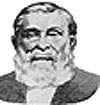
(1820-1885)
|
Anthony William Gardiner was the president of Liberia from 1878 until 1883. He was the second member of the
True Whig Party to hold that office, and the first of a series of True Whig presidents who held power
uninterruptedly until 1980. Gardiner was upset that Liberia could not protect its claim to the Gallinas,
a northern coastal area between the Mano and Sewa Rivers, from European colonial encroachment. Economically
and militarily weak, Liberia was forced to allow the British to annex the area next to Sierra Leone.
Gardiner was so upset in the way the British took part of Liberia's territory, he resigned from office and
vice-president Alfred F. Russell became president.
Gardiner was born in the state of Virginia in the United States. In 1831, when he was still a child, his
family relocated to Liberia under the sponsorship of the American Colonization Society. Gardiner received his
law decree in Liberia and, in 1847, he served as a delegate to the National Convention, which drafted Liberia's
declaration of independence and constitution. He became Liberia's first attorney general and later served in the
National Legislature from 1855 to 1871.
|
|
GBANGA
|
Gbarnga is a town in Bong County, Liberia, lying north east of Monrovia. During the Liberian Civil War,
it was the base for Charles Taylor's National Patriotic Front of Liberia. Cuttington College lies near
the town and its campus was once home to the Africana Museum, now destroyed.
The town is twinned with Baltimore, Maryland, in the United States.
|
|
GBARPOLU COUNTY
|
Created in 2001, Gbarpolu is the youngest of Liberia's 15 counties. It is situated in the northwest of Liberia,
occupies an area of approximately 1,263 square miles, and was estimated to have a population of 131,227 inhabitants
before the war. Gbarpolu county is bordered by Lofa County to the north, Bomi County to the south, Bong County to
the west, and Grand Cape Mount County and Sierra Leone to the east.
There are 5 districts within Gbarpolu County: Bopolu - Bokomu - Belleh - Gbarma - Komgba.
The majority of Gbarpolu consists of forest. Mining was the primary economic activity prior to the Liberian
Civil War, in addition to subsistence farming. However, the war devastated all sectors of the county.
|
Garretson Wilmot Gibson
PRESIDENT

(May 20/1832 - April 26/1910)
|
Garretson Wilmot Gibson was President of Liberia from December 11, 1900, to January 4, 1904. Born in Maryland,
in the United States, his family emigrated to Liberia in 1835. After receiving an education in mission schools,
he returned to Maryland to study theology. Ordained a priest, he served as rector of the Episcopalian Trinity
Church in Monrovia. He also served as president of Liberia College (1892-1896).
With the election of William D. Coleman as president in 1896, Gibson was appointed Secretary of the Interior.
He was Secretary of State when Coleman resigned in 1900, and since there was no vice-president, Gibson was
chosen to succeed him. He won the election that same year, and served until 1904, when he was succeeded by
his Secretary of the Treasury, Arthur Barclay.
(From Wikipedia, the free encyclopedia)
|
Delcontee Glekiah
Miss Liberia USA 2005
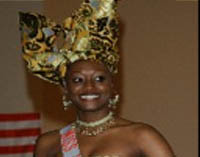
|
Delcontee Glekiah: Miss Liberia USA 2005
|
|
Global Witness

|
Study/background on the UN Sanctions (Resolutions 1343 United Nations Security Council).
Little revenue derived from the Liberian logging industry and from
the Liberian shipping register benefit the Liberian people.Were
sanctions to be placed on the shipping register – very few Liberian
jobs would be affected, while jobs held within the logging industry,
an estimated 8,000, are seasonal, insecure, and in large percentage
held by non-Liberians. In 5-10 years, at current logging practices,
Liberia is likely to be completely commercially logged out.At this
time there will be no jobs and no possibility of timber revenue for
the Liberian people.The years leading up to this would be years
where regional insecurity would have a steady source of revenue,
where the people would continue to suffer intimidation by logging
company militias, and where the illicit arms trade would be permitted to continue.
|
|
Gola People
|
The Gola or Gula are a tribal people living in western Liberia and parts of eastern Sierra Leone.
The Gola language is part of the Southern branch of the West Atlantic language family; as of 1991,
it is spoken by approximately 107,000 persons.
Charles Taylor, who ruled Liberia between 1997 and 2003, was of mixed Gola and Americo-Liberian ancestry.
|
|
GRAND BASSA
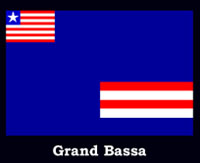
|
Grand Bassa is one of Liberia's 15 counties. Buchanan is the county's capital. Among the county's notable
residents has been Anthony Gardiner, a president of Liberia during the 19th century.
|
|
GRAND CAPE MOUNT
|
Grand Cape Mount is the westernmost Liberian county. It borders Lofa, Gbarpolu, and Bomi counties.
|
|
GRAND GEDAH
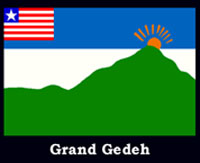
|
Grand Gedeh is one of Liberia's 15 counties. Zwedru is the county's capital.
|
|
The Grand Gedeh Association

|
The Grand Gedeh Association in the Americas, Inc. is a nonprofit organization, founded in 1975,
in Brooklyn, New York. During the more than twenty-five years of existence, the association
has grown from just a New York-based organization to a national association, with nine chapters
in more than fifteen states. The objectives of the association are, fostering peace among Grand
Gedeans living in the United States and Canada,
and mobilizing resources for the reconstruction of Grand Gedeh County, Liberia.
|
|
GRAND KRU
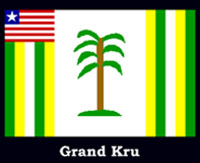
|
Grand Kru county was created in 1984/1985 by the merger of Sasstown Territory and Kru Coast Territory which had
previously been part of Maryland County. Grand Kru County is located along the coast of south eastern Liberia
bordered by Sinoe County to the northwest, River Gee County in the north east and Maryland County to the southeast.
Barclayville is the county capital. The county is divided into four districts: Sasstown, Buah, Upper Kru Coast
and Lower Kru Coast. The primary language is Grebo which is spoken in several significantly different dialects
around the county with some areas identifying their language as Kru. Liberian English is the language of school
instruction. A UN Mission in Liberia report issued in April 2005 estimates that 71,000 resident remain in the county.
The area has few roads which partially explains the relatively low population density. In June 2005 the UN
Integrated Regional Information Network reported that the roads in Grand Kru had decayed and become overgrown
by dense bush, rendering them impassable, except on foot, and that the bridge across the Nu River at Barclaville
had been destroyed. The primary industry is subsistence, largely slash and burn, farming. The most important
crops are upland rice, cassava, palm nuts, and along the coast, fishing. Feed corn is grown at higher elevations
farther inland. Sugar cane and several varieties of bananas grow in the wetland areas. Cash crops include coffee,
cocoa and kola. Locally grown bamboo and piassava are widely used for construction, mats and baskets.
Many tropical fruits, domestic and wild, grow in the region including oranges, limes, mangos, soursop, breadfruit
and coconut. Poultry, cattle, sheep and goats are found in and around most villages. Most animals are of pygmy
variety as larger varieties die quickly due to the heat and humidity. Prior to the civil war the region's extensive
rain forests contained a wide variety of wildlife including wild pigs, bongo, dik-dik, pangolin, civet, pygmy hippo,
African buffalo and colobus monkey all of which are hunted for food and hides. Also found are python, cassava snake,
and very small populations of forest elephants and leopards.
|
|
Greenville

|
Greenville, also known as Sinoe, is the capital of Sinoe County in Liberia and lies on a lagoon near the
Sinoe River and the Atlantic Ocean. The town was destroyed in the Liberian Civil War but has since been rebuilt
around a port for the local logging industry. The Sapo National Park lies near the town. Boats sail from
Greenville to Monrovia and Harper.
|
|
Next Link Page
|
Links in Alphabetic order
[A]
[B]
[C]
[D]
[E]
[F]
[G]
[H]
[I]
[J]
[K]
[L]
[M]
[N]
[O]
[P]
[Q]
[R]
[S]
[T]
[U]
[V]
[W]
[X]
[Y]
[Z]
|
|
To have your URL also added to these Liberian Internet gateways, please first forward an e-mail request to the LinkMaster at:
|
LinkMaster
All rights reserved!
|
|
|---|